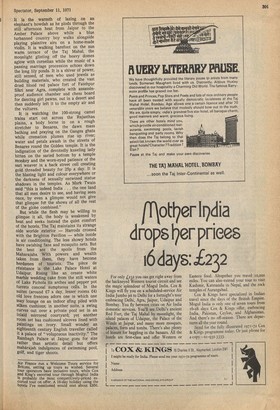INDIA: 2
Soft swish of salaams
CAROL WRIGHT
'Tourists are our honoured guests ' proclaim hoardings at every Indian airport. And in a country of poverty, the visitor feels himself so honoured, not just a bottomless piggy bank. In the press of people, people, and ever more people, pressing against one everywhere, the visitor lives under a kind of rarefied halo, welcomed to the humblest home, always offered food and drink. It's so cheap to play the old Raj, to buy precious stones in Jaipur; peacock fans for a few pence; to travel in car-borne comfort and live in sumpuous hotels.
The sight of poverty is not attractive. It starts at the dawn landing at Bombay driving from the airport past the blocks of shrouded bodies sleeping out the humid night along the road side. It come closer in the outstretched hands of beggars, most haunting in the eyes of little girls, more resistible in the clamour of snake charmers eager to stir up their sundazed horror baskets to fight with mongoose or drape a python round a tourist neck for a camera record.
But India's fecundity, with all its sadness, at least ensures service for visitors, service that our do-it-yourself society cannot but enjoy. Arriving at Bombay's Taj Mahal Hotel (the profits of which are uniquely given to charity by the wealthy owners) there's the soft swish of salaams along the lengthy corridor, the room servant immediately there to help, bring tea or cooling drinks, run a bath. At every hotel, the boy comes to help unpack, whisking away dusty shoes and sweat creased clothes for cleaning to maintain the imperturbable British facade on the most energetic tour. I recall a boy lighting a fire in a fireplace freshly whitewashed after each guest's departure in the Savoy Hotel at Ootacumund, then bearing in a tray of tea and eccles cakes. Ooty is time-frozen Victorian England set in Irish style green hills above the hot plains of the South. Its forever England-ness has been fossilised by the Indians who keep roses pruned in the former Governor's residence, shop at Charing Cross, and, dressed in tweed jackets and cords, drink their gins and tonic in the Club. In Rpay, red ,double decker buses nose t wugh the wandering sacred cows and a
Indicates the 'British Hairdressing
The richness and size of India's sightseeing overwhelms. Mogul magnificence in the north triumphs with the easy tour chain of air links from Bombay to Udaipur, Jaipur, Delhi, Kashmir, Agra and Benares. It is a John Masters' image of India: the maharajah's palaces, temples, jewelled elephants, moonlight on marble and precious stones. It is power and glory and ancient cruelty.
It is the warmth of lazing on an elephant's howdah as he plods through the still afternoon heat from Jaipur to the Amber Palace above while a blue turbanned country boy walks alongside playing plaintive airs on a home-made violin. It is walking barefoot on the sun warm terrace of the Taj Mahal, the moonlight glinting off the heavy domes aglow with cornelian while the music of a passing marriage procession echoes down the long lily ponds. It is a shiver of power, still sensed, of men who used jewels as building materials, who created the vast dried blood red palace fort of Fatehpur Sikri near Agra, complete with assassinproof audience chamber and chess board for dancing girl pawns, out in a desert and then suddenly left it to the empty air and the vultures.
It is watching the 100-strong camel trains start out across the Rajasthan plains, a body borne in on a rough stretcher to Benares, the dawn mass bathing and praying on the Ganges ghats while cremation plumes rise up river; water and petals awash in the streets of Benares round the Golden temple. It is the indignation of the devotedly kneeling lady bitten on the saried bottom by a temple monkey and the worn-eyed patience of the sari weaver in a back street cell creating gold threaded beauty for 25p a day. It is the blazing light and colour everywhere or the darkness of sexually entwined statue shadows in the temples. As Mark Twain said "this is indeed India . . . the one land that all men desire to see, and having seen once, by even a glimpse would not give that glimpse fot. the shows of all the rest of the globe combined."
But while the flesh may be willing to glimpse it all, the body is weakened by heat and seeks instead the quiet comfort of the hotels. The Taj maintains its strange olde worlde exterior — Harrods crossed With the Brighton Pavilion — while inside is air conditioning. The less showy hotels have swishing fans and mosquito nets. But the best are the spoils from the Maharajahs. With powers and wealth taken from them, they have become herdsmen of tourists. The piece de resistance is the Lake Palace Hotel at Udaipur. Rising like an ornate white marble wedding cake from the still waters of Lake Pichola its arches and pepper pot turrets conceal sumptuous cells. In the suites (around £7 a day, lesser rooms £4) old love frescoes adorn one in which one may lounge on an indoor sfing piled with silken cushions; in another suite, a swing curves out over a private pool set in an inlaid mirrored courtyard; yet another room set has cushioned alcoves lined with Paintings on ivory. Small wonder an eighteenth century English traveller called It a palace of "voluptuous inactivity." The Rambagh Palace at Jaipur goes for size rather than artistic detail but offers maharajah indulgences of swimming pool, golf, and tiger shoots.
Air France run a Welcome Tours service for Britons, setting up tours as wished. Several tour operators have inclusive tours, while Cox and King's escorted tour through Moghul India is probably the most competitively-priced escorted tour on offer. A 16-day holiday using the hotels I've mentioned would cost about £350.











































 Previous page
Previous page